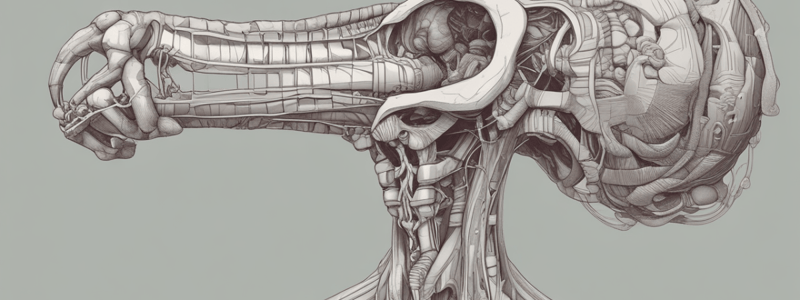Podcast
Questions and Answers
What is the length of the pharynx?
What is the length of the pharynx?
- 10-12 cm
- 18-20 cm
- 12-14 cm (correct)
- 15-17 cm
Which of the following bones is related to the superior end of the pharynx?
Which of the following bones is related to the superior end of the pharynx?
- Parietal bone
- Occipital bone
- Frontal bone
- Sphenoid bone (correct)
What is the width of the pharynx at its base?
What is the width of the pharynx at its base?
- 5.5 cm
- 4.5 cm
- 2.5 cm
- 3.5 cm (correct)
Which of the following is NOT a feature of the nasopharynx?
Which of the following is NOT a feature of the nasopharynx?
What is the function of the pharyngeal isthmus?
What is the function of the pharyngeal isthmus?
Which of the following arteries supplies the palatine tonsils?
Which of the following arteries supplies the palatine tonsils?
What is the boundary between the nasopharynx and the oropharynx?
What is the boundary between the nasopharynx and the oropharynx?
Which artery supplies the palatine tonsil?
Which artery supplies the palatine tonsil?
What is the function of the constrictor muscles of the pharynx?
What is the function of the constrictor muscles of the pharynx?
Which nerve innervates the stylopharyngeus muscle?
Which nerve innervates the stylopharyngeus muscle?
What is the location of the retropharyngeal lymph nodes?
What is the location of the retropharyngeal lymph nodes?
Which of the following muscles originates from the styloid process of the temporal bone?
Which of the following muscles originates from the styloid process of the temporal bone?
What is the function of the superior constrictor muscle?
What is the function of the superior constrictor muscle?
Which of the following nerves is located between the digastric and stylopharyngeus muscles?
Which of the following nerves is located between the digastric and stylopharyngeus muscles?
What is the origin of the palatopharyngeus muscle?
What is the origin of the palatopharyngeus muscle?
Flashcards are hidden until you start studying
Study Notes
Pharynx
- Common passage for air and food
- Extends between C1-C6 vertebrae, 12-15 cm long
- Superior end of respiratory and digestive tube
Dimensions
- Length: 12-14 cm
- Width: 3.5 cm at base, 1.5 cm at pharyngo-esophageal junction
Relations
- Superiorly: body of sphenoid, basilar portion of occipital bone
- Anteriorly: communicates with nasal cavity, oral cavity, and larynx
- Inferiorly: continuous with esophagus
- Posteriorly: C1-C6, longus capitis, longus coli, prevertebral fascia
Nasopharynx
- Located behind nasal cavity, above soft palate
- Anteriorly: related to nasal cavity
- Posteriorly: C1
- Superiorly: base of skull
- Inferiorly: oropharynx
- Features: pharyngeal opening of auditory tube, tubal elevation, salpingopharyngeal fold, salpingopalatine fold, pharyngeal recess, pharyngeal tonsil
Pharyngeal Isthmus (Nasopharyngeal Isthmus)
- An opening bounded by soft palate and posterior wall of pharynx (Passavant's ridge)
Oropharynx
- Anteriorly: related to oral cavity
- Posteriorly: level of body of C2 vertebra and upper part of C3
- Superiorly: nasopharynx
- Inferiorly: laryngopharynx
- Features: palatine tonsils
Laryngopharynx
- Extends from upper border of epiglottic cartilage to lower border of cricoid cartilage of larynx
- Anteriorly: related to laryngeal inlet, posterior surface of arytenoid and cricoid cartilage of larynx
- Posteriorly: C3-C6 vertebra
- Superiorly: oropharynx
- Inferiorly: esophagus
Muscles of Pharynx
- 3 pairs of constrictor muscles: superior, middle, and inferior constrictors
- 3 pairs of longitudinal muscles: stylopharyngeus, palatopharyngeus, salpingopharyngeus
Constrictor Muscles
- Superior constrictor: originates from medial pterygoid plate, pterygomandibular raphe, mandible, and side of tongue
- Middle constrictor: originates from greater and lesser horns of hyoid bone
- Inferior constrictor: originates from thyroid and cricoid cartilage of larynx
Longitudinal Muscles
- Stylopharyngeus: originates from styloid process of temporal bone
- Palatopharyngeus: originates from posterior part of hard palate
- Salpingopharyngeus: originates from cartilage of auditory tube
Retropharyngeal Lymph Nodes
- Located in retropharyngeal space behind pharynx
- Involved in drainage of lymph from several regions of head and neck
Studying That Suits You
Use AI to generate personalized quizzes and flashcards to suit your learning preferences.



